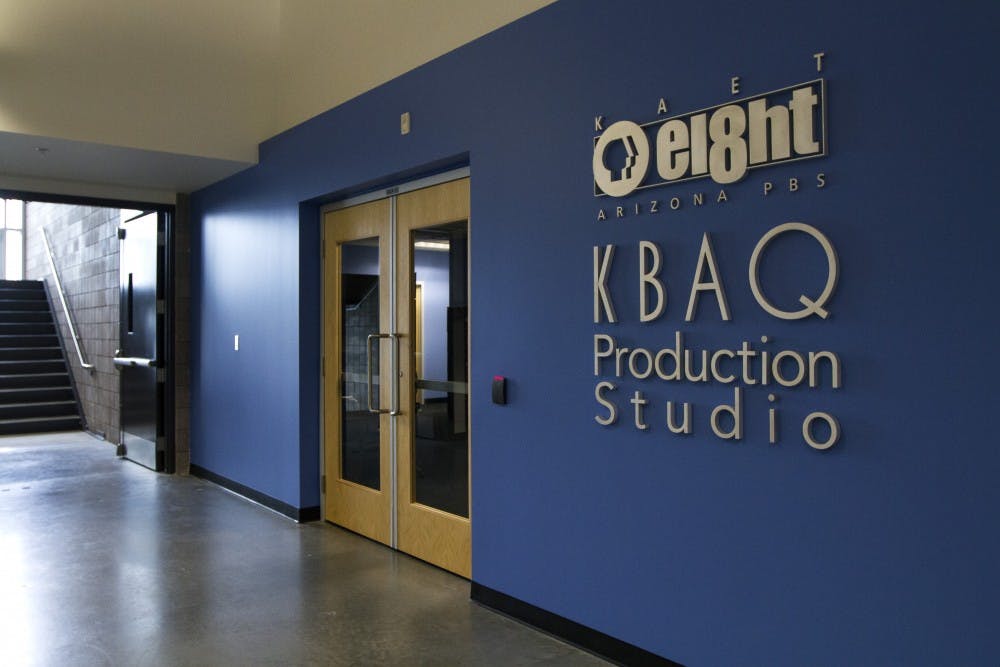 Eight, Arizona PBS, which has a station broadcast from the Cronkite building, will fully merge with the Walter Cronkite School of Journalism and Mass Communication. (Photo by Sean Logan)
Eight, Arizona PBS, which has a station broadcast from the Cronkite building, will fully merge with the Walter Cronkite School of Journalism and Mass Communication. (Photo by Sean Logan)Eight, Arizona PBS is the 12th largest TV market in the country. It's now the largest media outlet in the world that is run by a journalism school. Arizona PBS is viewed by more than a million people every week, reaches 2 million households and is broadcasted to 80 percent of the state.
ASU has restructured the deal with the station in which Eight, Arizona PBS will fully integrate with the Walter Cronkite School of Journalism and Mass Communication.
PBS already has a station broadcast from the Cronkite building, and the University has operated the station since 1961, Dean Christopher Callahan said. Many ASU students worked there, but the school and the station were never conjoined. Associate dean Kristin Gilger said this isolated PBS a little bit.
Kelly McCullough, Eight, Arizona PBS general manager, added that now that the two work closer together, new content can be produced easier.
“We’ve been sort of off to the side if you will for a while, we’re not an academic unit,” he said. “This gives us an opportunity to be better integrated into the University and frankly, it provides some new opportunities to fundraise and hopefully produce new content.”
He made it clear that it is still a PBS station, and will continue providing “signature PBS” kids' shows and local shows on their three channels.
Gilger said the merger gives PBS a chance to work with the education system at ASU through distribution.
“We have all these professional programs and many of those programs are producing content,” she said. “(PBS) is a big distribution platform so we anticipate that our students that are producing high-level content in our professional programs will have a new outlet for distributing their work.”
PBS has distributed Cronkite’s content in the past, but that was the majority of their relationship. Callahan said the school runs a newscast on PBS 8.3 four nights a week.
“That’s a great partnership, and that’s a great advantage for our students. This is going to be completely different,” he said.
He said the two entities are going to work together to create new content and new innovations. Gilger added that ASU is able to help with this due to the absence of financial pressures students face while broadcasting.
“We’re hoping that as part of this teaching hospital, we can do some of that ground-breaking testing and innovation on digital storytelling, audience engagement, new revenue models,” she said.
McCullough also described the plan as to be a “teaching hospital.” He compared it to hospitals in which students follow the doctor to get first-hand experience.
“(Students) will be in the trenches,” McCullough said. “It’s really about growing the on-the-job training aspects.”
Gilger said ASU and PBS work on finding new ways to reach and interact with audiences while pushing new content. This includes advancements of digital and online aspects.
Callahan added that the deal will not just affect journalism students at the University.
“We think it’s just going to be this real tremendous advantage for our Cronkite students, for other students at ASU and for Arizonans at large,” he said.
He referred to other students at ASU in the fact that he has reached out and spoken to heads of other schools including the film school about collaborating with the PBS at ASU.
“There’s an awful lot of partnerships that we think we can reach across the University well beyond the boundaries of the Cronkite school,” he said.
Reach the reporter at logan.newman@asu.edu or follow him on Twitter @Logan_Newsman




